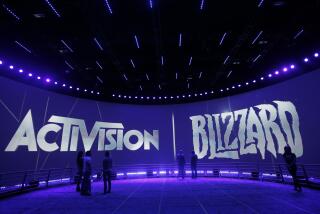Let Buyers Beware: Ratings Formulas May Be Complex : Television: Last year, the video game industry was under congressional pressure to devise a ratings system. But after disagreeing on how to classify content, it ended up with not one, but two.
- Share via
A team of men and women learning how to assess and rate interactive entertainment products last year had a problem with belching and flatulence: They didn’t know how to classify it. Actually, one video game in particular was causing the problem, featuring MTV’s infamous Beavis and Butt-head.
The gastrointestinal habits of the two animated misfits didn’t seem to fall under the usual categories for computer and video games that frequently involve the photo-realistic depiction of violent combat or sexual content.
“Being very sensitive to the fact that we don’t censor, I said we have a real problem here, because in certain cultures those behaviors are acceptable and even applauded,” said Arthur Pober, executive director of the Entertainment Software Rating Board.
So the research team dug up movie reviews of such classic gaseous films as “Blazing Saddles” and, more recently, “Dennis the Menace.” The researchers came across the words comic mischief and decided to use them as one of the “content descriptors” in their rating system.
“ ‘Comic mischief’ describes gross slapstick or vulgar situations,” Pober said. “We did research, talked to focus groups and they were pleased with that ‘descriptor.’ There’s nothing more confusing than having a rating system someone has to go to college to figure out.”
*
Devising a ratings system to classify entertainment products for parents is hardly an exact science. But that’s what Congress is trying to press the TV industry to do in order to enable parents to use a new V-chip technology that will enable them to block out programs with objectionable ratings.
Last year, the video game industry faced the same predicament the TV industry finds itself in today. Congress told software developers to create a voluntary ratings system to tip parents to objectionable content with warning labels, or else the government would enact strict laws forcing them to do so.
Today, the video game industry finds itself with not one, but two separate rating systems, each with its own icons and methodology. The original working group split--in part over the fundamental issue of which voluntary system works best.
The Entertainment Software Rating Board, formed with seed money by such industry giants as Sega and Nintendo, uses three trained raters per title to suggest an age range for specific products--from EC (Early Childhood) through AO (Adults Only)--similar to the system used by the Motion Picture Assn. of America with its movie ratings.
The game ratings are backed by content descriptors to elaborate the product’s content. “Animated Blood and Gore” is distinguished from “Realistic Blood and Gore,” and sexually “Suggestive Themes” are set apart from “Strong Sexual Content.”
On the other hand, the Recreational Software Advisory Council does not make age determinations in rating its computer software and video games. The group, established by the Software Publishers Assn., labels three areas of content--violence, language and sex--on a scale of one to four, illustrated with a thermometer.
The system requires the individual software publisher to answer a lengthy self-disclosure questionnaire, following a branching series of questions such as: “Does the software title depict blood and gore of sentient beings?” A published algorithm determines the content ratings.
Spot-checks by the council’s small staff ensures honest answers by the software publishers, as does a $10,000 fine if the content has not been fully disclosed.
From a philosophical standpoint, the council adapted a food-labeling system. Executive director Stephen Balkam’s research suggests that different children mature at different ages, so an age-based system is not appropriate.
“On a can of soup, you are told how much fat, sodium and carbohydrates are in the product,” Balkam said. “But the Food and Drug Administration doesn’t make a judgment as to whether somebody 350 pounds should purchase the soup.”
By contrast, “We felt very strongly we needed age-appropriate icons to help parents and consumers make judgment calls,” said Pober, who explored a number of different ratings systems from around the world. “What our system represents is a very good series of indicators for adults to say, ‘OK, this seems to fall into a category I don’t want my small children to watch.’ ”
Whether the TV industry goes one of these routes is less certain than whether it will go any route: The broadcast networks oppose implementing ratings that would make the V-chip technology work.





